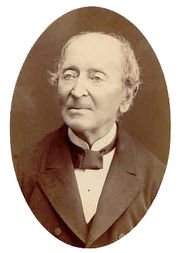Prominent Poles
Ignacy Domeyko (also spelled Domejko in Polish); Polish-Chilean geologist, mineralogist, educator

Born: July 31, 1802, Niedzwiadka, Russian partition of Poland, (presently Miadzviedka, Belarus)
Died: January 23, 1889, Santiago de Chile, Chile
Summary. In 1884, departing to partitioned Poland Domeyko, was greeted by an official Chilean daily this way: “ Not many examples can be quoted of life so industrious, so full of sacrifice, and so completely dedicated to education and to the progress of science. Mister Domeyko was more than a professor: he was an apostle of science in Chile. Unselfishness and contributions of Mister Domeyko obliged the Chilean people to an indescribable gratitude.”
Early days. Father, Antoni Hipolit, an estate owner, mother- Karolina nee Ancut. After the death of his father in 1809, Ignacy and his siblings- Maria, Antonina, Adam and Kazimierz- were brought up by their mother and two uncles. In 1812 Ignacy Domeyko went to the school in Szczucin which he finished in 1816. In the same year Domeyko started studies in the Physics and Mathematics Department of Wilno University under Jędrzej Śniadecki. In 1819 he joined the underground Philomats Society where he met and befriended Adam Mickiewicz and others. In 1822 he received the diploma of Master of Philosophy. In 1823 a betrayal caused the arrest of many of the Philomats. Domeyko was arrested too and put in a Basilians’ monastery. Thanks to his uncles he was released in 1824 but was sentenced to spend the rest of his life in the countryside under police supervision. For next few years he worked on his uncles’ estates. In 1829 the police supervision was revoked. After participating in the 1830 November Uprising Domeyko escaped to Prussia where he was interned. In 1832 he went together with Mickiewicz to Dresden and then to Paris. In 1834 he started studies in the Ecole des Mines (Mining School) which he finished in 1837 with a diploma of mining engineer. During his studies he prepared hydrographical, geological and forest maps of Poland.
Professional career, family life. Domeyko’s first job was in Bonne Fontaine in Alsace. In 1837 he was offered a position of a professor of chemistry and mineralogy in a Mining Schoool in La Serena in Chile. He accepted this offer and left for Chile in 1838. In 1844 he published two textbooks on mineralogy. In 1844 he went for several months to then independent Auracania. In 1845 he published “Araucania y sus habitantes" (Auracania and its inhabitants) in which he described geography, culture and habits of Auracania. This book was translated into several languages (first Polish translation in 1860). In 1846 he resigned from his position in La Serena and went to Valparaiso. In 1847 the Chilean government offered Domeyko a professorship of mineralogy and physics at the University of Santiago. He was also asked to reform not only this university but whole educational system in Chile. He used as educational models the Wilno School Districts and German universities. His project was ready for implementation in 1852. In 1848 the Chilean parliament awarded Domeyko honorary Chilean citizenship. In 1850 he married Enriqueta Sotomayor y Guzman. They had four children: Anna, Henryk, Hernan and Kazimierz. In 1867 he was nominated rector (president) of the University of Santiago and remained in this position for 16 years. In 1884 he departed from Santiago. On the way to his daughter Anna’s estate- Zyburtowszczyzna- he stopped in Cracow and in Warsaw. In the fall the same year he went to Berlin, Paris and then to Rome and Naples. A year later he returned to Zyburtowszczyzna and stayed there almost two years. In 1888 already seriously ill he went back to Santiago where he died soon after his return. His funeral in Chile became a national mourning.
Domeyko greatly advanced studies in mineralogy and mining techniques, researched several new minerals and advocated civil rights of the native tribal people. He was also a meteorologist and ethnographer. He published about 400 papers. He gained worlwide recognition wspecially for his work "Mineralogia que comprenda principalmente las especies minerales de Chili, Bolivia, Peru y Provincias Argentinas".
Honors. Several entities have been named in his honor, including the mineral Domeykit (Cu3As), the shellfish Nautilus domeykus, the ammonite Amonites domeykanus, the asteroid 2784 Domeyko, the flower- Viola domeykiana, a fox- Canis domeykanus, the Andean mountain range Cordillera Domeyko, the peak Cerro de Domeyko, two Chilean towns named Domeyko, a port- Puerto de Domeyko. After him are named the streets in Chilean cities: Santiago, La Serena and Valdivia and saltpeter mine in the Atalcama desert.
1873 Domeyko became a member of Academy of Sciences (Akademia Umiejetnosci) in Cracow
In 1887 he received a doctorate honoris causa from the Jagiellonian University in Cracow.
W 1903 r. The Chilean Government published a five volume set containing his research work. His memoirs-“Mis viajes"- were translated in several languages.
In 1973 Poland issued a stamp with Domeyko’s portrait
On the 200th Anniversary of Domeyko’s birth, UNESCO declared the year 2002 "Ignacy Domeyko Year." Several commemorative events were held in Chile under the auspices of Polish President Aleksander Kwasniewski and Chilean President Ricardo Lagos.
Source:
This article uses, among others, material from the Wikipedia article "Ignacy Domeyko" licensed under the GNU Free Documentation License. :
Wikipedia
with substantial additional information from:
Jadwiga Garbowska and Krzysztof Jakubowski (in Polish or in Belarussian). It also includes an extensive bibliography.
Return to home page:
Prominent Poles
